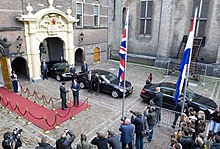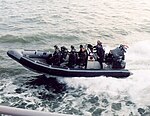Netherlands–United Kingdom relations
From Wikipedia, the free encyclopedia
The Netherlands and the United Kingdom are important partners both politically and economically. In February 1999, Tony Blair and Wim Kok agreed to intensify relations between the two countries. The United Kingdom and the Netherlands work closely with EU and foreign policy, social and employment policies and armed forces. At least forty Dutch towns and cities are twinned with British towns and cities. The English language and the Dutch language are both West Germanic languages, with Frisian, a minority language in the Netherlands being the closest relative of the English Language. 87% of people in the Netherlands claim to speak English.
The Netherlands has an embassy in London. The United Kingdom has an embassy in The Hague and a consulate in Amsterdam. The UK also has a consulate in Willemstad, Curaçao.
Contents[hide]
HistoricalAnglo Dutch WarsMain article: Anglo-Dutch Wars
The Anglo-Dutch wars were battles between England (and the Kingdom of Great Britain during the fourth war) and the Dutch Republic during the 17th and 18th centuries, there were four wars in total, two were won by ether sides, and ended with the Fourth Anglo-Dutch War. The wars were largely fought to secure trade routes and to enable colonial expansion. Glorious RevolutionMain article: Glorious Revolution
The Glorious Revolution, also called the Revolution of 1688, was the overthrow of King James II of England (VII of Scotland and II of Ireland) in 1688 by a union of Parliamentarians with an invading army led by the Dutch stadtholder William III of Orange-Nassau (William of Orange) who, as a result, ascended the English throne as William III of England. The crisis besetting King James II came to a head in 1688, when the King fathered a son, James Francis Edward Stuart on 10 June (Julian calendar), until then the throne would have passed to his daughter, Mary, a Protestant and the wife of William of Orange. The prospect of a Catholic dynasty in the kingdoms was now likely. Already troubled by the King’s Catholicism and his close ties with France, key leaders of the Tories united with members of the opposition Whigs and set out to resolve the crisis by inviting William of Orange to England. The invasion ended all attempts by England, in the Anglo-Dutch Wars of the 17th century, to subdue the Dutch Republic by military force. However, the personal union and the co-operation between the English and Dutch navies shifted the dominance in world trade from the Republic to England and then to the 18th century Kingdom of Great Britain. Eight Articles of LondonMain article: Eight Articles of London
The Eight Articles of London, also known as the London Protocol of June 21, 1814, were a secret convention between the Great Powers: United Kingdom of Great Britain and Ireland, Prussia,Austria, and Russia to award the territory of current Belgium and the Netherlands to William I of the Netherlands, then “Sovereign Prince” of the United Netherlands. He accepted this award on July 21, 1814. Anglo-Dutch Treaty of 1814Main article: Anglo-Dutch Treaty of 1814
The Anglo-Dutch Treaty of 1814 (also known as the Convention of London) was a treaty signed between the United Kingdom and the Netherlands in London on 13 August 1814. It was signed byRobert Stewart, Viscount Castlereagh, for the British and Hendrik Fagel for the Dutch. The treaty returned the colonial possessions of the Dutch as they were at 1 January 1803 before the outbreak of the Napoleonic Wars, in the Americas, Africa, and Asia with the exceptions of theCape of Good Hope and the South American settlements of Demerara, Essequibo, and Berbice, where the Dutch retained trading rights. In addition, the British ceded to the Dutch the island ofBanca in the Malay Archipelago in exchange for the settlement of Kochi and its dependencies on the coast of Malabar, in India. The Dutch also ceded the district of Barnagore, situated close toCalcutta, in exchange for an annual fee. The treaty also noted a declaration of 15 June 1814, by the Dutch that ships for the slave trade were no longer permitted in British ports and it agreed that this restriction would be extended to a ban on involvement in the slave trade by Dutch citizens. Britain also agreed to pay £1,000,000 to Sweden to resolve a claim to the Caribbean island ofGuadeloupe (see Guadeloupe Fund). The British and the Dutch agreed to spend £2,000,000 each on improving the defences of the Low Countries. More funds, of up to £3,000,000, are mentioned for the “final and satisfactory settlement of the Low Countries in union with Holland.” Disputes arising from this treaty were the subject of the Anglo-Dutch Treaty of 1824. Anglo-Dutch Treaty of 1824Main article: Anglo-Dutch Treaty of 1824
The Anglo-Dutch Treaty of 1824, also known as the Treaty of London (one of several), was a treaty signed between the United Kingdom and the United Kingdom of the Netherlands in London on 17 March 1824. The treaty was to resolve disputes arising from the execution of the Anglo-Dutch Treaty of 1814. For the Dutch, it was signed by Hendrik Fagel and Anton Reinhard Falck and for the UK, George Canning and Charles Watkin Williams Wynn. World War IIDuring World War II the United Kingdom and the Netherlands were close allies. After the German occupation of the Netherlands, Queen Wilhelmina and the Dutch government were able to find refuge in Britain. The Royal Netherlands Navy had managed to get most of its ships to England. One of these, the light cruiser Jacob van Heemskerk was not finished yet and had to be towed. A few Dutch pilots also had escaped and joined the Royal Air Force to fight in the Battle of Britain. In July 1940, two all-Dutch squadrons were formed with personnel and Fokker seaplanes from the Dutch naval air force: 320 Squadron and 321 Squadron (which afterwards moved to Sri Lanka). In 1943, an all-Dutch fighter squadron was formed in the UK, 322 Squadron. Political relationship
Dutch Prime Minister Mark Rutte meets Britain’s Deputy Prime Minister Nick Clegg at the Binnenhof in The Hague. As both the United Kingdom and the Netherlands are members of the European Union, the two countries have a strong relationship. Both countries are run under a constitutional monarchy. Queen Beatrix of the Netherlands is 830th in line to the British throne. The United Kingdom and the Netherlands cooperate on a project to help people living in the developing world adapt to climate change. The Infrared Astronomical Satellite was the first-ever space-based observatory to perform a survey of the entire sky at infrared wavelengths. Launched on January 25, 1983, its mission lasted ten months. The telescope was a joint project of the Netherlands (NIVR), and the United Kingdom (SERC) as well as the USA. While commenting on British-Dutch relations Douglas Henderson stated in 1997 that:
His Dutch counterpart Frits Bolkestein responded by saying:
Economic partnershipSee also: Icesave dispute
The United Kingdom and the Netherlands are close economic partners. Royal Dutch Shell and Unilever are both joint British/Dutch businesses. The Netherlands-British Chamber of Commerce was established in order to further economic cooperation between the two countries. In 2006 the Netherlands imported £16.6bn worth of goods from the United Kingdom, making it the UK’s fifth biggest export market. Dutch-British trade is made simpler by good relations, transparent legal framework, sophisticated financial services system, good transport links and close geographical proximity. The transportation links between the two countries are highly developed, it is possible to reach either country by train, Eurostar, ferry or aeroplane. Armed forces
Dutch Marines in a British made Rigid-hulled inflatable boat The British and Dutch armed forces share close relations. The Royal Marines and Netherlands Marine Corps are allied though a ‘Bond of friendship’. Since 1973, units of the Netherlands Marine Corps have formed part of the British 3 Commando Brigade during exercises and real conflict situations. Together, these form the UK/NL Landing Force. Either the First or the Second Marine Battalion can be assigned as the Dutch contribution to this force. The cooperation between the Korps Mariniers and the Royal Marines has led to extensive integration in the areas of operations, logistics and materials. Within NATO this is seen as a prime example of what can be achieved in military integration. The RNLMC and Royal Marines have a long history of cooperation. During combined actions by the British and Dutch navies during the War of the Spanish Succession (1702–1713), amphibious operations were carried out, the most notable being the Siege of Gibraltar in 1704. During this action, a successful attack was carried out against the fortress of Gibraltar by an 1800-strong brigade of Dutch and British Marines under the command of Prince George of Hesse-Darmstadt. Both corps share this battle honour. The nickname of the Dutch Marines among their British Royal Marine counterparts is “Cloggies,” due to the stereotype that most or all Dutch wear clogs, instead of “normal” footwear. Royal Navy Submarine Service officers taking the Submarine Command Course use a Dutch submarine simulator for part of the course See also
External links
Further reading
References
|
